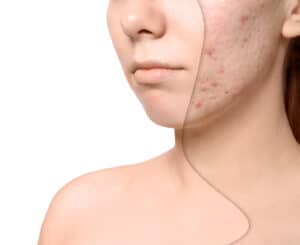
Acne plagues many people in adolescence and can affect adults well into their 20s and 30s. These pimples, blemishes or marks can be painful and embarrassing and may leave scars behind as a constant reminder of your struggle to achieve clear skin. Dr. Arie Benchetrit in Montreal and Pointe Claire offers acne treatment with photodynamic therapy for moderate to severe acne.
Acne blocks the pores with oil (sebum), hair, dead skin cells and bacteria, causing blackheads, whiteheads, nodules and other types of pimples to form. While these blemishes affect an estimated 80% of people between 11 and 30, it’s challenging to live with, especially when it persists into adulthood.
How Does Photodynamic Therapy for Acne Work?
Photodynamic therapy uses a type of photosensitizer in conjunction with oxygen and a light source to improve acne. A 2017 review of the research and literature on this acne treatment found that using 5-aminolevulinic acid (Levulan) or methyl aminolevulinate as the photosensitizing agent achieved similar results and that most variations use intense pulsed light (IPL) or red light. These combinations improved inflammatory and non-inflammatory lesions in people struggling with mild to severe acne.
Dr. Benchetrit begins acne treatment with photodynamic therapy by cleansing the skin, and he may incorporate microdermabrasion or skin exfoliation to improve results. Levulan is then applied to the skin for up to an hour to target the overactive sebaceous glands that lead to acne formation. (Photodynamic therapy also targets pre-cancerous, early cancerous and melanin-producing cells.) The Levulan is activated by IPL or blue light to destroy the targeted cells.
After photodynamic therapy, the skin may appear red, and some patients experience swelling around the eyes or lips for up to 48 hours after treatment. Peeling or crusting may occur, but the healing period is not painful. Some patients respond well to a single treatment, while others require a series of three or more for the best improvement in acne and skin tone, texture and appearance.
Photodynamic Therapy vs. Other Acne Treatments
Topical creams, oral antibiotics and other options such as Accutane are common first-line treatments for acne. Unfortunately, many people experience adverse side effects or unsatisfactory results with these options. Photodynamic therapy could be a more effective tool for people who have failed to improve acne with these traditional methods because this treatment shrinks the oil glands and decreases oil production. Research suggests photodynamic therapy is a more effective solution for acne and an adjunctive option (meaning in addition to other treatments) for mild to severe acne that does not respond to topicals or oral medications.
If you struggle with acne, contact Dr. Benchetrit to discuss your skin condition and treatment options. Schedule a consultation at our Montreal or Pointe Claire, Quebec offices by calling (514) 613-4355.
















